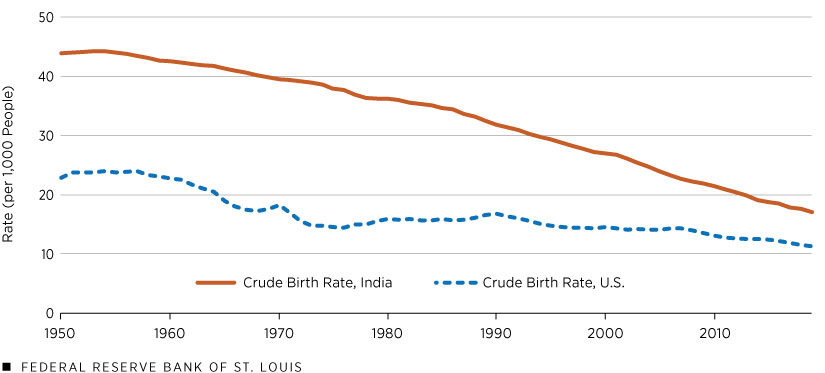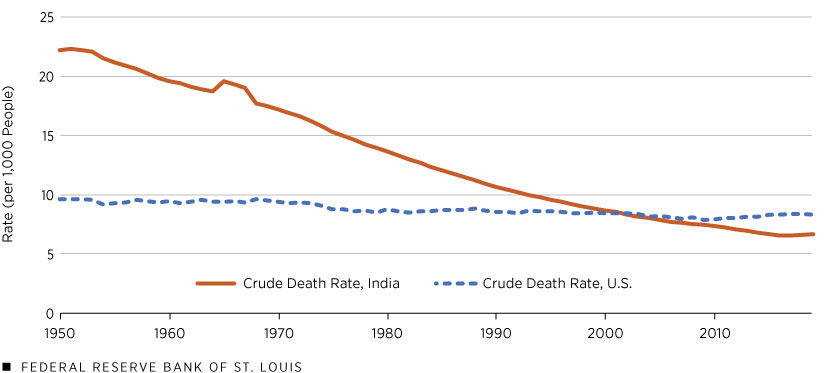Birth Rates, Death Rates and the World’s Population Dynamics
The world’s population has grown from 3 billion in 1960 to 8 billion in 2022. What have been the forces behind this dramatic increase?
B. Ravikumar, a senior vice president and deputy director of research at the St. Louis Fed, and Research Associate Iris Arbogast explored this question in a recent Regional Economist article about the rapid rise in global population.
Ravikumar and Arbogast noted that popular discussion about controlling population growth has tended to focus on birth rates. But they pointed out that this is only part of the equation: The population growth rate is equal to the birth rate minus the death rate.
“While the earlier overpopulation discussion emphasized the role of birth rates, it failed to account for how the decline in death rates affects population growth,” they wrote.
To better understand this growth, the authors studied the role that the death rate played in global population dynamics, focusing on the experience of India.
India Saw Steady Population Growth amid a Declining Birth Rate
The authors pointed to the significant drop in India’s birth rate; it fell from 44 per thousand people in 1950 to 32 per thousand people in 1990. It then fell further to 17 per thousand people in 2019, nearing the U.S. birth rate of about 11 per thousand people. (See the figure below.)
“Despite the decline in birth rate, however, the population growth rate stayed the same, around 2.25%, from 1950 to 1990. So, why the discrepancy?” they wrote.
Crude Birth Rates in the U.S. and India, 1950-2019

SOURCE: United Nations, World Population Prospects 2022.
NOTE: Crude birth rate is the number of live births per 1,000 people.
India’s Falling Death Rate More Than Offset the Impact of Its Falling Birth Rate
Despite the drop in the birth rate, India saw its population steadily grow because the country also experienced a steep decline in death rates. Its death rate tumbled from 22 deaths per thousand people in 1950 to 10.7 deaths per thousand people in 1990. It then kept falling to 6.7 per thousand people by 2019, which is lower than the U.S. death rate in that same year. (In comparison, the U.S. death rate slipped from 9.6 per thousand people in 1950 to 8.3 per thousand people in 2019.)
Crude Death Rates in the U.S. and India, 1950-2019

SOURCE: United Nations, World Population Prospects 2022.
NOTE: Crude death rate is the number of deaths per 1,000 people.
How India’s Falling Death Rate Affected the Global Population
What was the significance of India’s declining death rate? To gauge this, Ravikumar and Arbogast calculated what the size of India’s population would have been if the country’s death rate had remained unchanged since 1950 while birth rates declined at the historical pace.
In reality, the country’s population grew from 360 million in 1950 to nearly 1.4 billion in 2019. But in the counterfactual example, “India’s population increased from 360 million to only 760 million in 2019,” the authors wrote. “That’s a difference of about 640 million fewer people.”
Thus, if the counterfactual example had occurred, the world’s population would have fallen by that same number, they noted.
Citation
ldquoBirth Rates, Death Rates and the World’s Population Dynamics,rdquo St. Louis Fed On the Economy, Jan. 31, 2023.
This blog offers commentary, analysis and data from our economists and experts. Views expressed are not necessarily those of the St. Louis Fed or Federal Reserve System.
Email Us
All other blog-related questions

